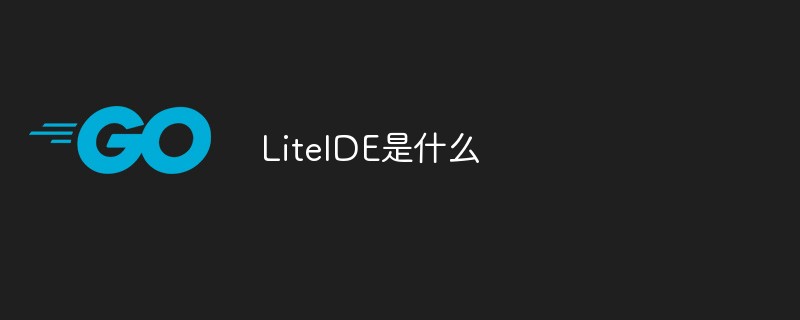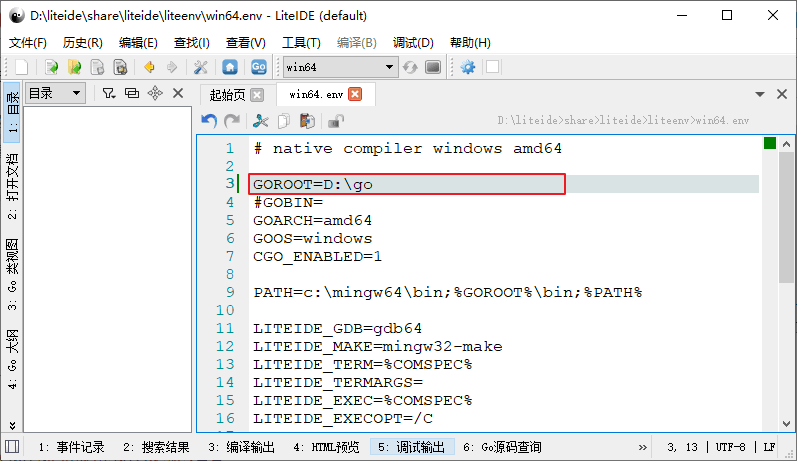What is LiteIDE
LiteIDE is an open source, cross-platform, lightweight integrated development environment (IDE) specially designed for Go language development. It is a development tool for Go language and is developed based on Qt (a cross-platform C framework), supporting Windows, Linux and Mac OS X platforms.

The operating environment of this tutorial: Windows 10 system, LiteIDE X36 version, Dell G3 computer.
LiteIDE is an open source, cross-platform, lightweight integrated development environment (IDE) specially designed for Go language development. It is developed based on Qt (a cross-platform C framework) and supports Windows, Linux and Mac OS X platform. The first version of LiteIDE was released in early January 2011 and is one of the earliest IDEs for the Go language.
LiteIDE has very good support for editing, compiling and running Go programs and projects. It also includes an abstract syntax tree view of the source code and some built-in tools (this development environment was developed by the Chinese uncle vfc).
LiteIDE is a very easy-to-use lightweight Go integrated development environment (based on QT, Kate and SciTE), including cross-platform development and other necessary features, for code writing, automatic completion and operation Debugging has excellent support. It uses the concept of Go projects to browse and manage project files. It also supports the function of switching between various Go development environments and cross-compilation.
At the same time, it has the function of abstract syntax tree view, which can clearly overview the constants, variables, functions, different types and their properties and methods in the project.
Download LiteIDE
You can download the LiteIDE installation package through the following methods:
Open source software platform: https://sourceforge.net/projects/liteide/files/;
In this section we need to download the Windows version of LiteIDE installation package.

Because LiteIDE is a green version and does not require installation, after the download is completed, you will get a compressed file in ZIP format.

Extract the compressed package to any directory. Here we decompress the compressed package to the D drive. After decompression, you will get a folder named "liteide".

Enter the bin folder in the LiteIDE folder. You can find a file named "liteide.exe" in the bin folder, which is the startup program of LiteIDE.

Double-click to run "liteide.exe" to open LiteIDE normally. In order to facilitate future use, it is recommended that you create a shortcut to LiteIDE on the desktop (in "liteide.exe "Right-click → "Send to" → "Desktop Shortcut").

Configuring LiteIDE
To modify the current running environment, you need to set the corresponding running settings according to different systems Environment, because we are using a 64-bit Windows system, we need to set the running environment to Win64.

Configure the current running environment, click "Tools" and select "Edit Current Environment" in the drop-down menu, as shown in the figure below.

Find "GOROOT=xxx" in the opened file and modify it to the value corresponding to GOROOT in the environment variable, as shown below. (Note: Remember to save after the modification is completed)

It doesn’t matter if you can’t remember clearly. You can use the go env command in the CMD window to view the corresponding value of GOROOT.
Add a custom GOPATH and find "Manage GOPATH/Modules..." in the "Tools" menu, as shown in the figure below. (Note: Because the system already contains a default GOPATH, this step is not necessary, just understand it)
Find "Use custom GOPATH" in the pop-up window, check it, then click "Add Directory" and select the appropriate directory.
New project
At this point LiteIDE has been basically configured, let’s create it now A project to test it out.
First, select "New" in the "File" menu, in the pop-up window, select the system default GOPATH path, select "Go1 Command Project" as the template, and finally fill in the project name and select the appropriate directory. , click "OK" after confirming it is correct.
The newly created project is as follows. The editor automatically created two files for us and generated simple code in "main.go".
Click the "BR" button in the upper right corner of the editor to run the code in "main.go" and generate an .exe file in the current directory. executable file.
[Related recommendations: Go video tutorial, Programming teaching】
The above is the detailed content of What is LiteIDE. For more information, please follow other related articles on the PHP Chinese website!

Hot AI Tools

Undresser.AI Undress
AI-powered app for creating realistic nude photos

AI Clothes Remover
Online AI tool for removing clothes from photos.

Undress AI Tool
Undress images for free

Clothoff.io
AI clothes remover

AI Hentai Generator
Generate AI Hentai for free.

Hot Article

Hot Tools

Notepad++7.3.1
Easy-to-use and free code editor

SublimeText3 Chinese version
Chinese version, very easy to use

Zend Studio 13.0.1
Powerful PHP integrated development environment

Dreamweaver CS6
Visual web development tools

SublimeText3 Mac version
God-level code editing software (SublimeText3)

Hot Topics
 What is the problem with Queue thread in Go's crawler Colly?
Apr 02, 2025 pm 02:09 PM
What is the problem with Queue thread in Go's crawler Colly?
Apr 02, 2025 pm 02:09 PM
Queue threading problem in Go crawler Colly explores the problem of using the Colly crawler library in Go language, developers often encounter problems with threads and request queues. �...
 Which libraries in Go are developed by large companies or provided by well-known open source projects?
Apr 02, 2025 pm 04:12 PM
Which libraries in Go are developed by large companies or provided by well-known open source projects?
Apr 02, 2025 pm 04:12 PM
Which libraries in Go are developed by large companies or well-known open source projects? When programming in Go, developers often encounter some common needs, ...
 What libraries are used for floating point number operations in Go?
Apr 02, 2025 pm 02:06 PM
What libraries are used for floating point number operations in Go?
Apr 02, 2025 pm 02:06 PM
The library used for floating-point number operation in Go language introduces how to ensure the accuracy is...
 In Go, why does printing strings with Println and string() functions have different effects?
Apr 02, 2025 pm 02:03 PM
In Go, why does printing strings with Println and string() functions have different effects?
Apr 02, 2025 pm 02:03 PM
The difference between string printing in Go language: The difference in the effect of using Println and string() functions is in Go...
 How to ensure concurrency is safe and efficient when writing multi-process logs?
Apr 02, 2025 pm 03:51 PM
How to ensure concurrency is safe and efficient when writing multi-process logs?
Apr 02, 2025 pm 03:51 PM
Efficiently handle concurrency security issues in multi-process log writing. Multiple processes write the same log file at the same time. How to ensure concurrency is safe and efficient? This is a...
 How to solve the problem that custom structure labels in Goland do not take effect?
Apr 02, 2025 pm 12:51 PM
How to solve the problem that custom structure labels in Goland do not take effect?
Apr 02, 2025 pm 12:51 PM
Regarding the problem of custom structure tags in Goland When using Goland for Go language development, you often encounter some configuration problems. One of them is...
 How to use Golang to implement Caddy-like background running, stop and reload functions?
Apr 02, 2025 pm 02:12 PM
How to use Golang to implement Caddy-like background running, stop and reload functions?
Apr 02, 2025 pm 02:12 PM
How to implement background running, stopping and reloading functions in Golang? During the programming process, we often need to implement background operation and stop...
 What is the difference between `var` and `type` keyword definition structure in Go language?
Apr 02, 2025 pm 12:57 PM
What is the difference between `var` and `type` keyword definition structure in Go language?
Apr 02, 2025 pm 12:57 PM
Two ways to define structures in Go language: the difference between var and type keywords. When defining structures, Go language often sees two different ways of writing: First...












